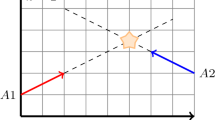Abstract
A mixed integer linear optimization model is presented for providing a cooperative system between Air Traffic Control Officers who manage the airspace for aircraft conflict detection and resolution. Elsewhere we have introduced the model for dealing with velocity and altitude changes in a given air sector. In this work, we extend the model to cover the important problem of coordinating the decisions of the Air Traffic Control Officers of different air sectors. The new model allows the aircraft to ascend or descend one or more altitude levels. It is so tight that a state-of-the-art mixed integer linear optimization solver provides the solution in a very affordable computing time even for large-scale instances. It is worth pointing out that only in very few pilot instances of the testbed, the software engine needs to use the branch-and-cut phase of the solver.




Similar content being viewed by others
References
Alonso-Ayuso, A., Escudero, L. F., & Martín-Campo, F. J. (2011). Collision avoidance in the air traffic management: a mixed integer linear optimization approach. IEEE Transactions on Intelligent Transportation Systems, 12(1), 47–57.
Alonso-Ayuso, A., Escudero, L. F., & Martín-Campo, F. J. (2012). A mixed 0–1 nonlinear approach for the collision avoidance in atm: velocity changes through a time horizon. Computers & Operations Research, 39(12), 3136–3146.
Alonso-Ayuso, A., Escudero, L. F., Olaso, P., & Pizarro, C. (2011, in press). Conflict avoidance: 0–1 linear models for conflict detection & resolution. Top. doi:10.1007/s11750-011-0224-6.
Cafieri, S., & Durand, N. (2012, submitted for publication). Aircraft deconfliction with speed regulation: new models from mixed-integer optimization.
Christodoulou, M. A., & Kodaxakis, S. G. (2006). Automatic commercial aircraft-collision avoidance in free flight: the three-dimensional problem. IEEE Transactions on Intelligent Transportation Systems, 7(2), 242–249.
Dell’Olmo, P., & Lulli, G. (2003). A new hierarchical architecture for air traffic management: optimization of airway capacity in a free flight scenario. European Journal of Operational Research, 144, 179–193.
Eurocontrol (2012). Fasti ATCO manual. http://www.eurocontrol.int/fasti, last accessed in January 2012.
IBM ILOG (2009). CPLEX v12.1. User’s manual for CPLEX.
Kuchar, J. K., & Yang, L. C. (2000). A review of conflict detection and resolution modeling methods. IEEE Transactions on Intelligent Transportation Systems, 1(4), 179–189.
Martín-Campo, F. J. (2010). The collision avoidance problem: methods and algorithms. Saarbrücken: Lambert Academic Publishing.
Pallottino, L., Feron, E., & Bicchi, A. (2002). Conflict resolution problems for air traffic management systems solved with mixed integer programming. IEEE Transactions on Intelligent Transportation Systems, 3(1), 3–11.
Rey, D., Rapine, C., Fondacci, R., & El Faouzi, N.-E. (2012). Minimization of potentials air conflicts through speed regulation. Transportation Research Record, 2300, 59–67.
Richards, A., & How, J. P. (2002). Aircraft trajectory planning with collision avoidance using mixed integer linear programming. In Proceedings of the American control conference (Vol. 3, pp. 1936–1941).
Richards, A., Schouwenaars, T., How, J. P., & Feron, E. (2002). Spacecraft trajectory planning with avoidance constraints using mixed-integer linear programming. AIAA Journal on Guidance, Control & Dynamics, 25(4), 755–764.
Vela, A., Solak, S., Singhose, W., & Clarke, J.-P. (2009). A mixed-integer program for flightlevel assignment and speed control for conflict resolution. In: Proceedings of the joint 48th IEEE conference on decision and control and 28th Chinese control conference, Shanghai. New York: IEEE Press.
Acknowledgements
This research has been also partially supported by the projects PLANIN MTM2009-14087-C04-01 and OPTIMOS2 MTM2009-14039-C06-03 funded by the Ministry of Science and Innovation (MICINN), Spain. The authors are grateful to the two anonymous reviewers that have greatly helped to improve the presentation of the paper and the clarification of some concepts.
Author information
Authors and Affiliations
Corresponding author
Rights and permissions
About this article
Cite this article
Alonso-Ayuso, A., Escudero, L.F. & Martín-Campo, F.J. On modeling the air traffic control coordination in the collision avoidance problem by mixed integer linear optimization. Ann Oper Res 222, 89–105 (2014). https://doi.org/10.1007/s10479-013-1347-y
Published:
Issue Date:
DOI: https://doi.org/10.1007/s10479-013-1347-y




